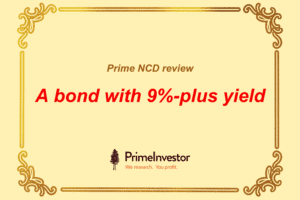Prime Funds is the list of funds that we recommend. This fund list uses Prime Ratings as a first filter, over which we analyse portfolios, strategy, market scenario and much more. Many of you have asked us how we differ from the various MF recommendations out there in the market.
Here’s what we aim for, in Prime Funds:
- To have a range of investment styles. This is important, because as we have stressed many times, mixing different strategies is what is needed to build a diversified portfolio. So by ensuring that each Prime Fund is unique, it is easy for you to mix and match what you need.
- To keep it concise. If we had dozens of funds in the list, it could make it confusing to go through and pick the fund that suits you. It would also lead us to have a lot of duplication in strategies and portfolios, which could translate into your portfolio.
- To go beyond just the rating. If we used just the Prime Rating, all 5-star funds would make the cut. But we go by the fund’s strategy, its suitability for a portfolio, whether there are other different funds to be had, and what market conditions are like.
- To avoid being defined by categories. What matters is a fund’s suitability to a particular purpose. Constraining the list to categories could mean fewer options – so in debt funds, for example, we are perfectly comfortable putting a short-maturity fund in a 5+ year horizon as their low volatility and stable strategy make them suitable to form the debt component of long-term portfolios.
We hope that this gives you a better understanding of what Prime Funds is about.
We would also like to highlight some key points you should note while using Prime Funds:
- Prime funds is our hand-picked list of funds. However, there are many good funds outside of it that we would not have brought into this list – both to keep the list short and to avoid duplication. If you do not find your fund in Prime funds it does not mean you need to exit it. Please use our MF Review Tool to know if the fund you hold is good or not. In other words, use our review tool to assess your existing funds.
- We try to write in detail about our Prime Funds by coming up with periodic research reports (called Prime Recommendation). You don’t need to invest in every fund we write about. Unless it fits your overall portfolio/strategy, or there is something lacking, there is little need for you to go on adding funds. For example, if you already hold a midcap fund from our list or one that is a buy in our review tool and we write about one more midcap fund from our list, it DOES NOT MEAN that you need to sell your existing fund. You can add it IF your portfolio can accommodate it based on your strategy/timeframe/need. Our purpose behind such reviews is to give you a detailed picture of the fund we have in our recommended list.
With that done, the changes we have made in this review cycle are below. We have explained what you should do with funds we have removed from the list. Please read it carefully if you are invested in them. Funds we remove do not immediately call for a sell – it is just that they have slipped in performance marginally or there are better alternatives now. Unless our review tool says such funds are a ‘sell’, you can hold them. You can refer to our article on when to sell funds.

Prime Funds – Equity
Equity – Moderate
We have no changes in this list and like mentioned in the last quarter, our dark horse pick – Canara Robeco Equity Diversified has gained a significant lead over peers, with right weights in some outperforming stocks. Parag Parikh Long Term Equity too continued to remain head and shoulders over peers thanks to its international exposure and derivative calls. Do note that both these funds along with Kotak Standard Multicap await verdict from SEBI and then from AMCs on whether they will remain multicap or otherwise. You will hear from us on any change in strategy at that point.
Equity – Aggressive
We have added a lesser known candidate, Union Small Cap to our list of small-cap funds. This fund has been steadily improving in our ratings for 3 quarters now. While it has still not built a very long record of consistency, we think it warrants an entry in our list to catch further improvement in returns. It can be a candidate for those who like quality, nimble small-cap portfolios (needless to say, with high risks).
Union Small Cap has a high-quality portfolio whose stocks have sound balance sheet metrics. Many of the stocks in the portfolio have been highly resilient to the March 2020 correction. This is further reinforced by the resilience in earnings shown even in the difficult quarters of March and June. We think these are important traits in a small cap stock and when a fund manager adheres to it in a disciplined way, the portfolio delivers.
Since the addition of fund manager and CIO Vinay Paharia, a seasoned and balanced and less-hyped mid & smallcap manager in April 2018, the fund has seen a steady pick up to the extent of outperforming even top players like SBI Small Cap over a rolling 1-year basis in recent times. Its compact AUM is a big plus. Watch out for our detailed coverage of this fund soon!
This is an early call on this fund that otherwise has a volatile and chequered past. Make sure you do not go overboard on this fund and note that our call may change if there is any fund manager change, in this case.
Equity – Tax-saving
Tax-saving fund Canara Robeco Tax saver is not too different from its multicap cousin Canara Robeco Equity Diversified. As is the case with many funds in the AMC, this fund too has significantly moved up the performance charts, as similar stocks calls across the fund house proved to be winners.
A predominantly growth strategy with some value has helped retain a healthy mix of stocks that perform across market cycles. Still, its chequered track record is visible as you go down the returns calendar. Hence, prefer this as an addition only after the other 2 funds in our list. It also shares significant overlap with Canara Robeco Equity Diversified, so be aware of potential duplication if you wish to invest in this fund.
Equity – Passive funds
To invest in the Nifty Next 50 index, we have added UTI Nifty Next 50 to our existing recommendation of ICICI Pru Nifty Next 50. The Next 50 index is a good index to have in long-term portfolios. Though a large-cap index, it delivers more along the lines of a mid-cap index. It is thus a good route to better returns, even for those shy of taking pure mid-cap and small-cap exposure.
Up until recently, the ICICI fund was the only viable option which had a track record long enough to assess tracking error. UTI Next 50 is now two years in existence, and therefore provides enough history to gauge tracking error. On this front, it is very similar to ICICI Next 50 in both short-term and long-term period tracking errors. UTI Next 50’s expense ratio (in the regular plan) is on par with the ICICI Pru fund, as well, and lower in the direct plan. If you already have investments in ICICI Pru Next 50, please continue to hold and invest.
Strategy/ thematic
In this set of Prime Funds, we’re adding two more. The first is BNP Paribas India Consumption fund. Consumption demand is a mix of urban and rural demand. The latter has held up and can continue to do so given the potentially good harvest. Consumer companies across the board – from auto to FMCG to durables to other discretionary – are also pushing forth discounts and other marketing activities to drive demand through the upcoming festival period. This can boost urban demand as well. Consumer companies are reporting a recovery in demand that is nearing pre-Covid levels. Consumption therefore can see upticks quicker than other more cyclical companies.
These are short-term drivers, but even from a longer-term perspective consumption as a theme can hold up well. One, it encompasses a diverse range of sectors – staple FMCGs, entertainment, consumer durables, jewellery, auto, travel and more all derive growth from consumer demand. Banking, financial services, cement, tiles, and paints are other sectors that are linked to more spending. Two, the sector diversity touches different price points and different consumer pockets. Three, in several of these sectors, stocks can hold up in the face of market corrections.
BNP Paribas India Consumption balances out exposure across these stocks more evenly than other consumer-themed funds. It does not have a track record since it was launched just two years ago. In this limited history, it has done better and been less volatile than peers.
The second theme we’ve added is ICICI Banking & Financial Services as a tactical play on NBFCs and banks. If there is a play on broad economic growth, it is financials. Whether through growth in retail demand or industrial, banks and NBFCs are well-placed to capture any economic revival. Banks, of course, are an economy’s backbone and no revival is possible without lifting banks as well.
We have additionally focused on financial-themed funds that have a good exposure to NBFCS. Through the lockdown, NBFCs were heavily impacted given the uncertainty over the loan moratorium, their ability to collect payments from their vast retail borrowers, and on their own funding side. The post-Covid moratorium period suggests that NBFCs have been able to recover loans better than expected. They are also very well-placed to make the most of a retail consumption recovery. Their valuations are also lower than at the start of this year.
Compared to its peers, ICICI Banking & Financial Services has heavier weights to NBFCs. It also tends to deliver far better than peer funds during upturns – but it also means that you will need to book profits as it can lose significantly during a downturn. The other financials-themed fund in our list – SBI Banking & Financial Services – is more weighted towards banks, and is less volatile.
In both the above funds, your risk appetite needs to be high. Do not allow your total allocation to thematic funds to form more than 15-20% of your portfolio even if these themes are a little more evergreen.
Prime Funds – Hybrid
Hybrid – Low risk
For those of you who want a fund that dynamically allocates to equity but is primarily meant to contain downsides well, DSP Dynamic Asset Allocation can be a good option. This fund’s ability to contain downsides and generate superior risk-adjusted returns is significantly higher than peers.
Even so, temper your return expectations as this category is only meant to generate debt-plus returns. You will still need a 1-3 year time frame for this fund as it has generated negative returns of even up to 10% over 1-month periods in sharp equity corrections. It uses fundamental valuation metrics with technicals to manage the asset allocation between equity and debt and hedge equity with derivatives.
A slightly more aggressive fund in this category – ICICI Pru Balanced Advantage has been shifted to the hybrid – aggressive category primarily because of its higher unhedged equity exposure than peers and higher volatility as a result. However, this fund can generate superior returns than other balanced advantage peers over 2-year periods. You can continue to hold and invest in this fund. Just be aware that it is more volatile than its category peers.
Both the above funds are suitable primarily for those with 1-3 year time frame (ideally requiring debt allocation) but want superior tax efficiency than debt funds. The risk, too, is higher than debt as a result of unhedged equity exposure.
Prime Funds – Debt
Debt – liquid
We recommend liquid funds only for those looking for such funds to hold money for a very short period, or as part of emergency portfolio, or to generate steady income through SWPs. Do note that if you have STP requirements, you should definitely choose a liquid fund in the same fund house in which you have chosen the equity fund, whether it is in our list or not.
In this review, we have added Aditya Birla SL Liquid fund. We have removed UTI Liquid Cash Plan. We have made this change as the ABSL fund has a marginally higher portfolio yield and average short-term returns and has managed this for several months now. Its expense ratio is lower than category on the regular plan and on par with better performing peers on the direct plan. It has a very large AUM as well.
If you already hold UTI Liquid Cash Plan as part of any portfolio, emergency or short-term or otherwise, continue to hold it. There is absolutely no reason to change your fund, as it continues to be low on expense ratio and deliver steadily well and has a very large AUM. As such, there is very little difference between liquid funds in terms of their returns or risk.
Debt – very short-term: 3 months to 1.5 years
In this Prime Funds set, we have added Nippon India Money Market and removed Kotak Money Market. Nippon India Money Market has been slightly ahead of Kotak Money Market in recent returns. Measured against the category average, Nippon Money Market scores very well on short-term consistency, beating the average over half the time. On this front, it is a notch ahead of the Kotak fund.
Nippon Money Market is also much lower than the category on expense ratio – in the direct plan, for instance, its August expense is at 0.15%, compared to the 0.29% for the category. The fund does not take credit risk. it is lower-volatile than the category and has by far fewer instances of incurring losses in very short periods such as 1 week compared to funds with similar maturities/portfolios.
If you hold Kotak Money Market, please continue to stay invested for your time frame and do not switch. The fund remains a buy in our review tool, as it still delivers above category average, is low on expense ratio, and large on AUM. Our call in removing this fund from our list is simply to offer a better performer given the very short-term nature of this category.
You can view the full list of Prime Funds here. This update on Prime Funds is the second in our review cycle. The first was on changes in our buy/ sell/ hold calls in our MF Review Tool. You can access this report here.




17 thoughts on “Quarterly review – changes in Prime Funds, our mutual fund recommendations”
resp madam
i am looking for , invest and forget type of stratigy for long period time frame.
is it better to go for balanced adv funds or go for say 50/50 index debt combination and rebance.
also will it be possible to give approx portfolio returns in readymade potfolios
regards
umesh
Hello sir,
You can go for index funds + debt fund combination. This will give you more control over your portfolio and allow you to keep the equity allocation at levels that are more suited for your timeframe/risk. A balanced advantage fund will not suit your purpose as asset allocation is out of your hands and good balanced advantage funds tend to be more conservative. We have discussed balanced advantage funds here.
For readymade portfolios, we’re not showing track record right now because we launched our portfolios only in January and we do not want to claim a record we don’t have by showing long-term returns. We will see if we can provide current returns of the funds.
Thanks,
Bhavana
thanks
regards
umesh
In evaluation of low AUM small cap funds, did the team also look at other small cap funds like Canara Robeco Small Cap, Invesco Small Cap before finalising the call on Union Small Cap? The small cap offerings from Canara Robeco and Invesco AMCs have more or less same managers, analyst teams which has made CR Equity Diversified, CR Tax Saver, Invesco Contra, Invesco Growth Opportunities, Invesco Contra worthy of being Prime funds.
Also, the Sep direct plan expense ration of Union Small cap is 1.82%, where as it is ~0.8-0.9% for Canara Robeco, Invesco Small Cap offerings. Was this considered as well?
Hello sir,
Yes, we have looked at the funds you have mentioned. There are several reasons for going with Union Small cap, which we will explain in detail. But when we draw up the list, we also look at giving a variety in terms of the nature/ strategy of funds. For example, we already have Invesco Mid Cap, so adding yet another Invesco fund in the small-cap space was avoidable. We have looked at expense ratios as well, and aware that they are higher. But returns are post expense ratios and Union has been beating other funds on returns despite the higher expenses.
Thanks,
Bhavana
Looking forward to the detailed analysis for Union Small Cap. If possible, please extend the comparative analysis to Canara Robeco, Invesco, Edelweiss small cap offerings in comparison to Union small cap.
Hi Mam There are no opinions published about Quant funds which has been doing well (though recently)
There isn’t enough track record to do so. But we have covered one individually https://primeinvestor.in/a-quant-fund-that-can-challenge-active-funds/ and one in our ETF section. Thanks, Vidya
Great efforts!
I have to enter into Small Cap Fund. Shall I go with Union Small Cap (3*) or Axis Small Cap (4.5). I am confused now. Please help me guide.
Also, what is schedule of detailed coverage on Union Small Cap?
THe coverage will happen within 2 weeks. We will be unable to take the call for you 🙂 We have highlighted the individual risks in ‘why this fund’ column in our Prime funds. Please choose what fits your risk appetite. Thanks, Vidya
I am disappointed you are skewed towards on
Active MF. You promised direct stock review for long term investment latest by Aug . However,nothing happened except excuses. Reviewing direct stock is not taboo. After all , Equity Mutual funds comprises only stocks. I do not understand the reason for your not focussing on direct equity. Your platform is ready reconer for Mutual Funds only with occasional reference to passive funds, ETFs and Fixed Income. In my opinion, speculation is bad but certainly not stock.
We’re sorry to disappoint you. But I do remember writing last quarter to a same blog query and did not make any promose on date. Our forte is MFs and ETFs and fixed income and stocks will only be a good add on. Kindly let us be the judge on what we need to cover based on our current investor interst. Please base your expectations accordingly. thanks, Vidya
Does your ‘No Opinion’ on ICICI Multi Asset fund stay?
Regards,Praveen
Hello sir,
Please check the MF Review tool for our views on funds.
Thanks,
Bhavana
Will these changes be applied to the “Ready-to-use Porfolios” as well? For example, “Time-frame < 1 yr" is still showing UTI liquid.
Hello sir,
We haven’t yet updated Prime Portfolios. We complete the Prime Funds first, and other recommendations before doing the portfolios since they draw from multiple products.
Thanks,
Bhavana
Thanks for the response
Comments are closed.